HRM Essay: Role of Recruitment and Selection in Employee Retention
VerifiedAdded on 2020/03/16
|8
|2167
|72
Essay
AI Summary
This essay provides a comprehensive overview of the recruitment and selection processes within Human Resource Management (HRM) and their crucial role in attracting and retaining employees. It begins by defining recruitment and selection, highlighting their significance in organizational growth and employee turnover. The essay then delves into the factors influencing recruitment, such as vacancy characteristics, candidate attributes, recruitment sources, and the impact of a positive work environment. It explores the importance of effective recruitment and selection for filling positions with the right candidates and the use of compensation strategies and organizational image to attract talent. The essay discusses internal and external recruitment sources, emphasizing the use of advertisements and employment agencies. Furthermore, it examines the key elements that attract qualified candidates, including salary, benefits, and job satisfaction. The essay also details the selection process, emphasizing standards like reliability, validity, and generalizability. It explores different selection methods, such as interviews and cognitive ability assessments, and concludes by emphasizing the importance of understanding employee needs to improve retention. References to Google's recruitment strategies and benefits are used to illustrate the points.
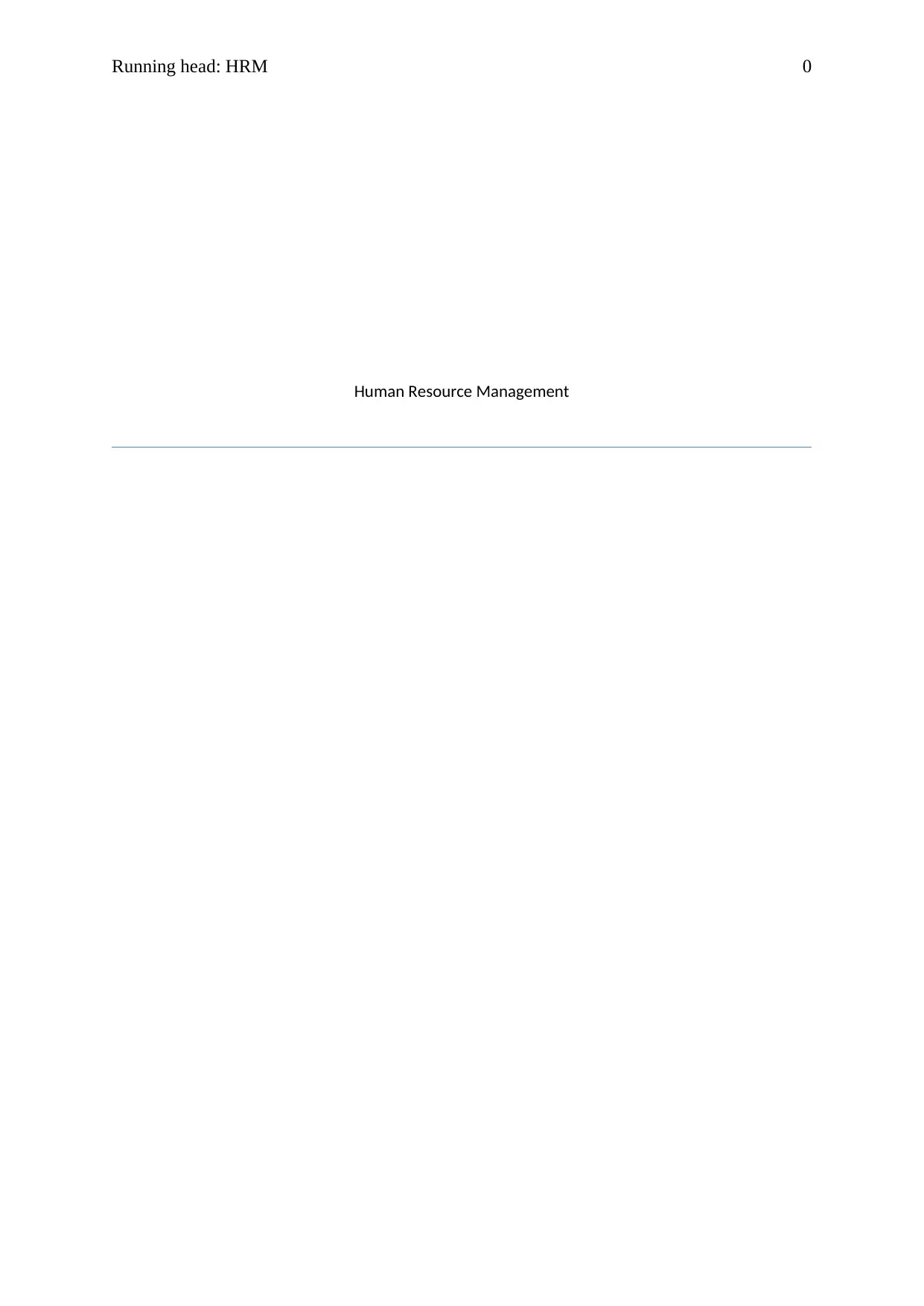
Running head: HRM 0
Human Resource Management
Human Resource Management
Paraphrase This Document
Need a fresh take? Get an instant paraphrase of this document with our AI Paraphraser
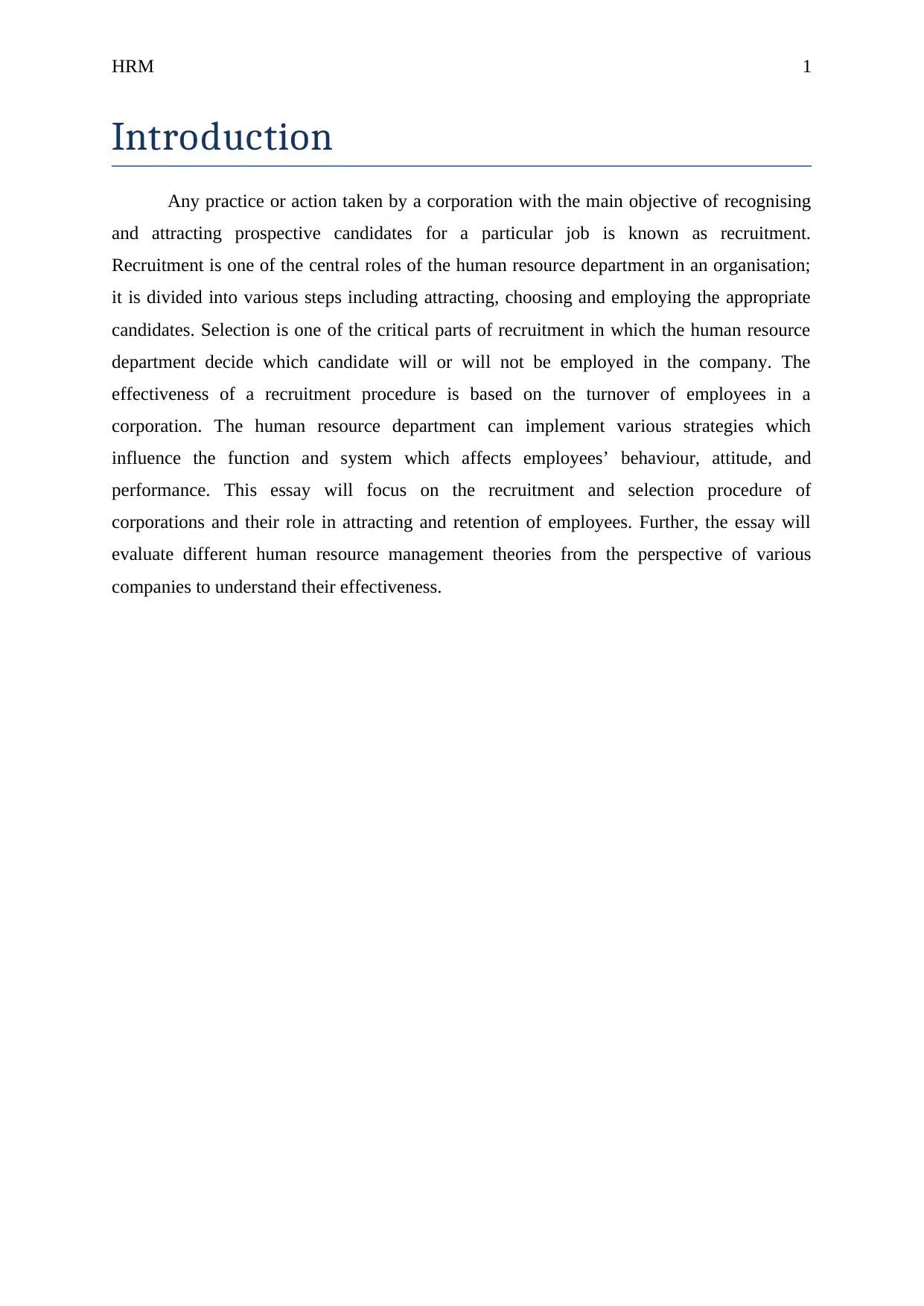
HRM 1
Introduction
Any practice or action taken by a corporation with the main objective of recognising
and attracting prospective candidates for a particular job is known as recruitment.
Recruitment is one of the central roles of the human resource department in an organisation;
it is divided into various steps including attracting, choosing and employing the appropriate
candidates. Selection is one of the critical parts of recruitment in which the human resource
department decide which candidate will or will not be employed in the company. The
effectiveness of a recruitment procedure is based on the turnover of employees in a
corporation. The human resource department can implement various strategies which
influence the function and system which affects employees’ behaviour, attitude, and
performance. This essay will focus on the recruitment and selection procedure of
corporations and their role in attracting and retention of employees. Further, the essay will
evaluate different human resource management theories from the perspective of various
companies to understand their effectiveness.
Introduction
Any practice or action taken by a corporation with the main objective of recognising
and attracting prospective candidates for a particular job is known as recruitment.
Recruitment is one of the central roles of the human resource department in an organisation;
it is divided into various steps including attracting, choosing and employing the appropriate
candidates. Selection is one of the critical parts of recruitment in which the human resource
department decide which candidate will or will not be employed in the company. The
effectiveness of a recruitment procedure is based on the turnover of employees in a
corporation. The human resource department can implement various strategies which
influence the function and system which affects employees’ behaviour, attitude, and
performance. This essay will focus on the recruitment and selection procedure of
corporations and their role in attracting and retention of employees. Further, the essay will
evaluate different human resource management theories from the perspective of various
companies to understand their effectiveness.
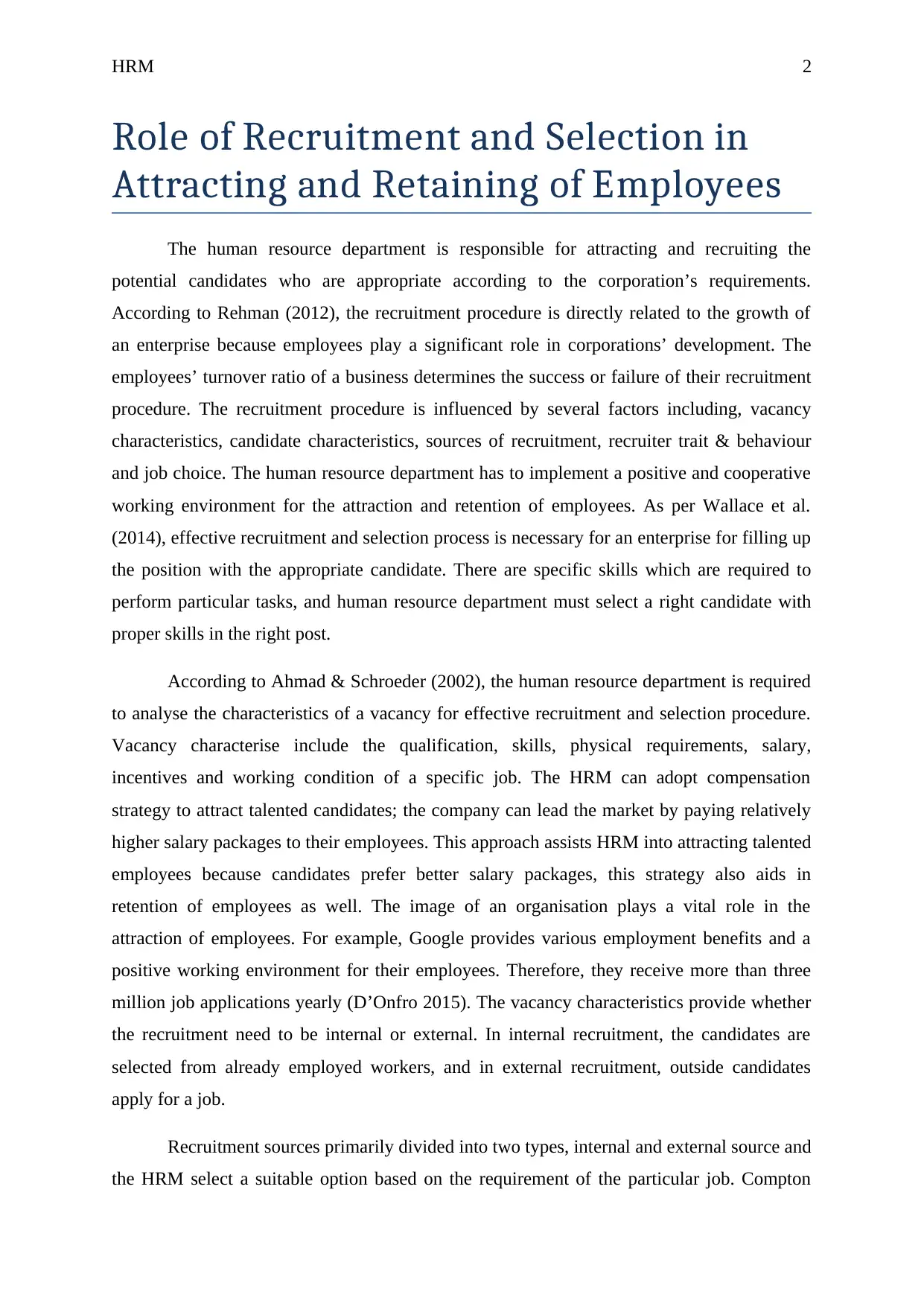
HRM 2
Role of Recruitment and Selection in
Attracting and Retaining of Employees
The human resource department is responsible for attracting and recruiting the
potential candidates who are appropriate according to the corporation’s requirements.
According to Rehman (2012), the recruitment procedure is directly related to the growth of
an enterprise because employees play a significant role in corporations’ development. The
employees’ turnover ratio of a business determines the success or failure of their recruitment
procedure. The recruitment procedure is influenced by several factors including, vacancy
characteristics, candidate characteristics, sources of recruitment, recruiter trait & behaviour
and job choice. The human resource department has to implement a positive and cooperative
working environment for the attraction and retention of employees. As per Wallace et al.
(2014), effective recruitment and selection process is necessary for an enterprise for filling up
the position with the appropriate candidate. There are specific skills which are required to
perform particular tasks, and human resource department must select a right candidate with
proper skills in the right post.
According to Ahmad & Schroeder (2002), the human resource department is required
to analyse the characteristics of a vacancy for effective recruitment and selection procedure.
Vacancy characterise include the qualification, skills, physical requirements, salary,
incentives and working condition of a specific job. The HRM can adopt compensation
strategy to attract talented candidates; the company can lead the market by paying relatively
higher salary packages to their employees. This approach assists HRM into attracting talented
employees because candidates prefer better salary packages, this strategy also aids in
retention of employees as well. The image of an organisation plays a vital role in the
attraction of employees. For example, Google provides various employment benefits and a
positive working environment for their employees. Therefore, they receive more than three
million job applications yearly (D’Onfro 2015). The vacancy characteristics provide whether
the recruitment need to be internal or external. In internal recruitment, the candidates are
selected from already employed workers, and in external recruitment, outside candidates
apply for a job.
Recruitment sources primarily divided into two types, internal and external source and
the HRM select a suitable option based on the requirement of the particular job. Compton
Role of Recruitment and Selection in
Attracting and Retaining of Employees
The human resource department is responsible for attracting and recruiting the
potential candidates who are appropriate according to the corporation’s requirements.
According to Rehman (2012), the recruitment procedure is directly related to the growth of
an enterprise because employees play a significant role in corporations’ development. The
employees’ turnover ratio of a business determines the success or failure of their recruitment
procedure. The recruitment procedure is influenced by several factors including, vacancy
characteristics, candidate characteristics, sources of recruitment, recruiter trait & behaviour
and job choice. The human resource department has to implement a positive and cooperative
working environment for the attraction and retention of employees. As per Wallace et al.
(2014), effective recruitment and selection process is necessary for an enterprise for filling up
the position with the appropriate candidate. There are specific skills which are required to
perform particular tasks, and human resource department must select a right candidate with
proper skills in the right post.
According to Ahmad & Schroeder (2002), the human resource department is required
to analyse the characteristics of a vacancy for effective recruitment and selection procedure.
Vacancy characterise include the qualification, skills, physical requirements, salary,
incentives and working condition of a specific job. The HRM can adopt compensation
strategy to attract talented candidates; the company can lead the market by paying relatively
higher salary packages to their employees. This approach assists HRM into attracting talented
employees because candidates prefer better salary packages, this strategy also aids in
retention of employees as well. The image of an organisation plays a vital role in the
attraction of employees. For example, Google provides various employment benefits and a
positive working environment for their employees. Therefore, they receive more than three
million job applications yearly (D’Onfro 2015). The vacancy characteristics provide whether
the recruitment need to be internal or external. In internal recruitment, the candidates are
selected from already employed workers, and in external recruitment, outside candidates
apply for a job.
Recruitment sources primarily divided into two types, internal and external source and
the HRM select a suitable option based on the requirement of the particular job. Compton
⊘ This is a preview!⊘
Do you want full access?
Subscribe today to unlock all pages.

Trusted by 1+ million students worldwide
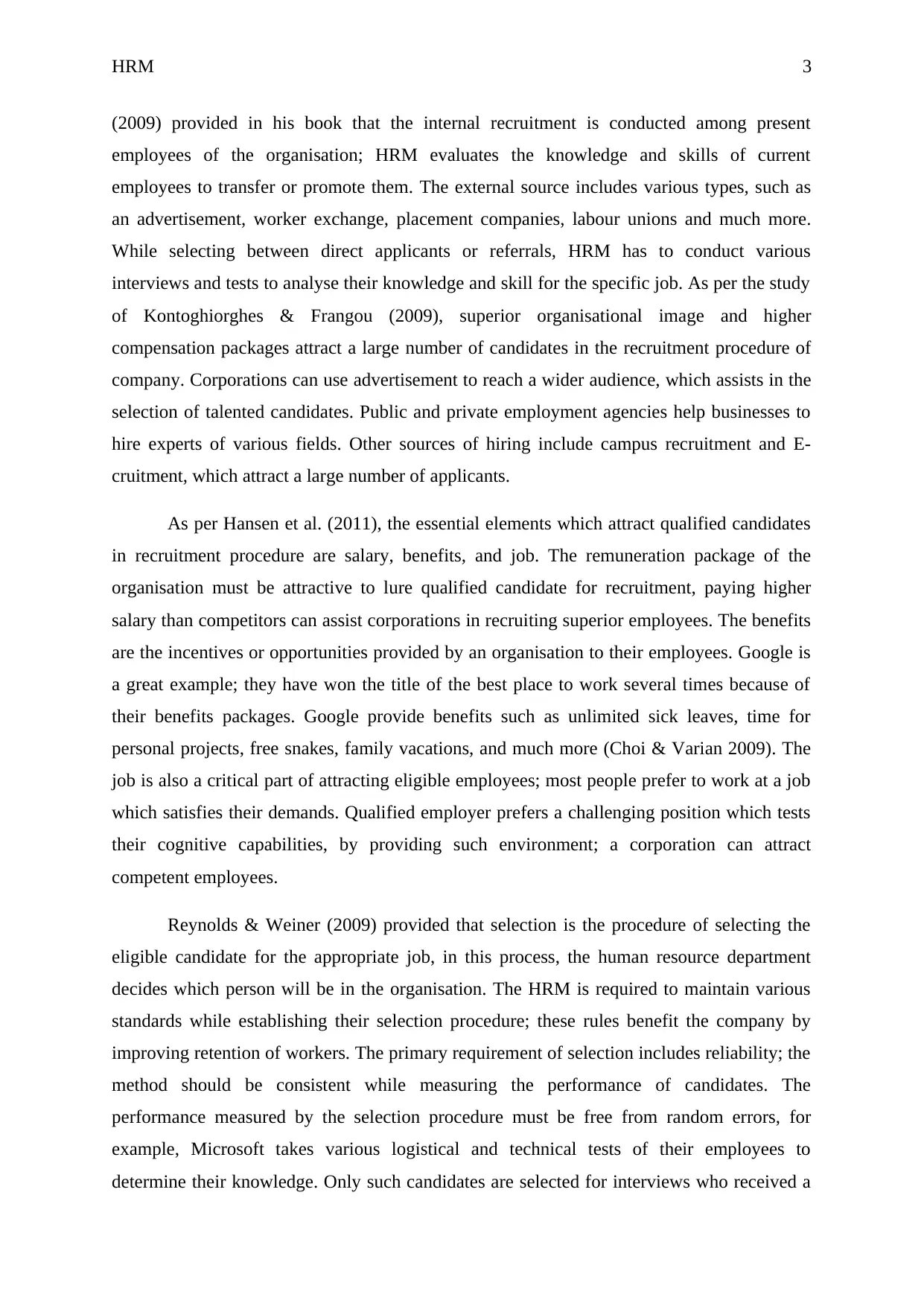
HRM 3
(2009) provided in his book that the internal recruitment is conducted among present
employees of the organisation; HRM evaluates the knowledge and skills of current
employees to transfer or promote them. The external source includes various types, such as
an advertisement, worker exchange, placement companies, labour unions and much more.
While selecting between direct applicants or referrals, HRM has to conduct various
interviews and tests to analyse their knowledge and skill for the specific job. As per the study
of Kontoghiorghes & Frangou (2009), superior organisational image and higher
compensation packages attract a large number of candidates in the recruitment procedure of
company. Corporations can use advertisement to reach a wider audience, which assists in the
selection of talented candidates. Public and private employment agencies help businesses to
hire experts of various fields. Other sources of hiring include campus recruitment and E-
cruitment, which attract a large number of applicants.
As per Hansen et al. (2011), the essential elements which attract qualified candidates
in recruitment procedure are salary, benefits, and job. The remuneration package of the
organisation must be attractive to lure qualified candidate for recruitment, paying higher
salary than competitors can assist corporations in recruiting superior employees. The benefits
are the incentives or opportunities provided by an organisation to their employees. Google is
a great example; they have won the title of the best place to work several times because of
their benefits packages. Google provide benefits such as unlimited sick leaves, time for
personal projects, free snakes, family vacations, and much more (Choi & Varian 2009). The
job is also a critical part of attracting eligible employees; most people prefer to work at a job
which satisfies their demands. Qualified employer prefers a challenging position which tests
their cognitive capabilities, by providing such environment; a corporation can attract
competent employees.
Reynolds & Weiner (2009) provided that selection is the procedure of selecting the
eligible candidate for the appropriate job, in this process, the human resource department
decides which person will be in the organisation. The HRM is required to maintain various
standards while establishing their selection procedure; these rules benefit the company by
improving retention of workers. The primary requirement of selection includes reliability; the
method should be consistent while measuring the performance of candidates. The
performance measured by the selection procedure must be free from random errors, for
example, Microsoft takes various logistical and technical tests of their employees to
determine their knowledge. Only such candidates are selected for interviews who received a
(2009) provided in his book that the internal recruitment is conducted among present
employees of the organisation; HRM evaluates the knowledge and skills of current
employees to transfer or promote them. The external source includes various types, such as
an advertisement, worker exchange, placement companies, labour unions and much more.
While selecting between direct applicants or referrals, HRM has to conduct various
interviews and tests to analyse their knowledge and skill for the specific job. As per the study
of Kontoghiorghes & Frangou (2009), superior organisational image and higher
compensation packages attract a large number of candidates in the recruitment procedure of
company. Corporations can use advertisement to reach a wider audience, which assists in the
selection of talented candidates. Public and private employment agencies help businesses to
hire experts of various fields. Other sources of hiring include campus recruitment and E-
cruitment, which attract a large number of applicants.
As per Hansen et al. (2011), the essential elements which attract qualified candidates
in recruitment procedure are salary, benefits, and job. The remuneration package of the
organisation must be attractive to lure qualified candidate for recruitment, paying higher
salary than competitors can assist corporations in recruiting superior employees. The benefits
are the incentives or opportunities provided by an organisation to their employees. Google is
a great example; they have won the title of the best place to work several times because of
their benefits packages. Google provide benefits such as unlimited sick leaves, time for
personal projects, free snakes, family vacations, and much more (Choi & Varian 2009). The
job is also a critical part of attracting eligible employees; most people prefer to work at a job
which satisfies their demands. Qualified employer prefers a challenging position which tests
their cognitive capabilities, by providing such environment; a corporation can attract
competent employees.
Reynolds & Weiner (2009) provided that selection is the procedure of selecting the
eligible candidate for the appropriate job, in this process, the human resource department
decides which person will be in the organisation. The HRM is required to maintain various
standards while establishing their selection procedure; these rules benefit the company by
improving retention of workers. The primary requirement of selection includes reliability; the
method should be consistent while measuring the performance of candidates. The
performance measured by the selection procedure must be free from random errors, for
example, Microsoft takes various logistical and technical tests of their employees to
determine their knowledge. Only such candidates are selected for interviews who received a
Paraphrase This Document
Need a fresh take? Get an instant paraphrase of this document with our AI Paraphraser
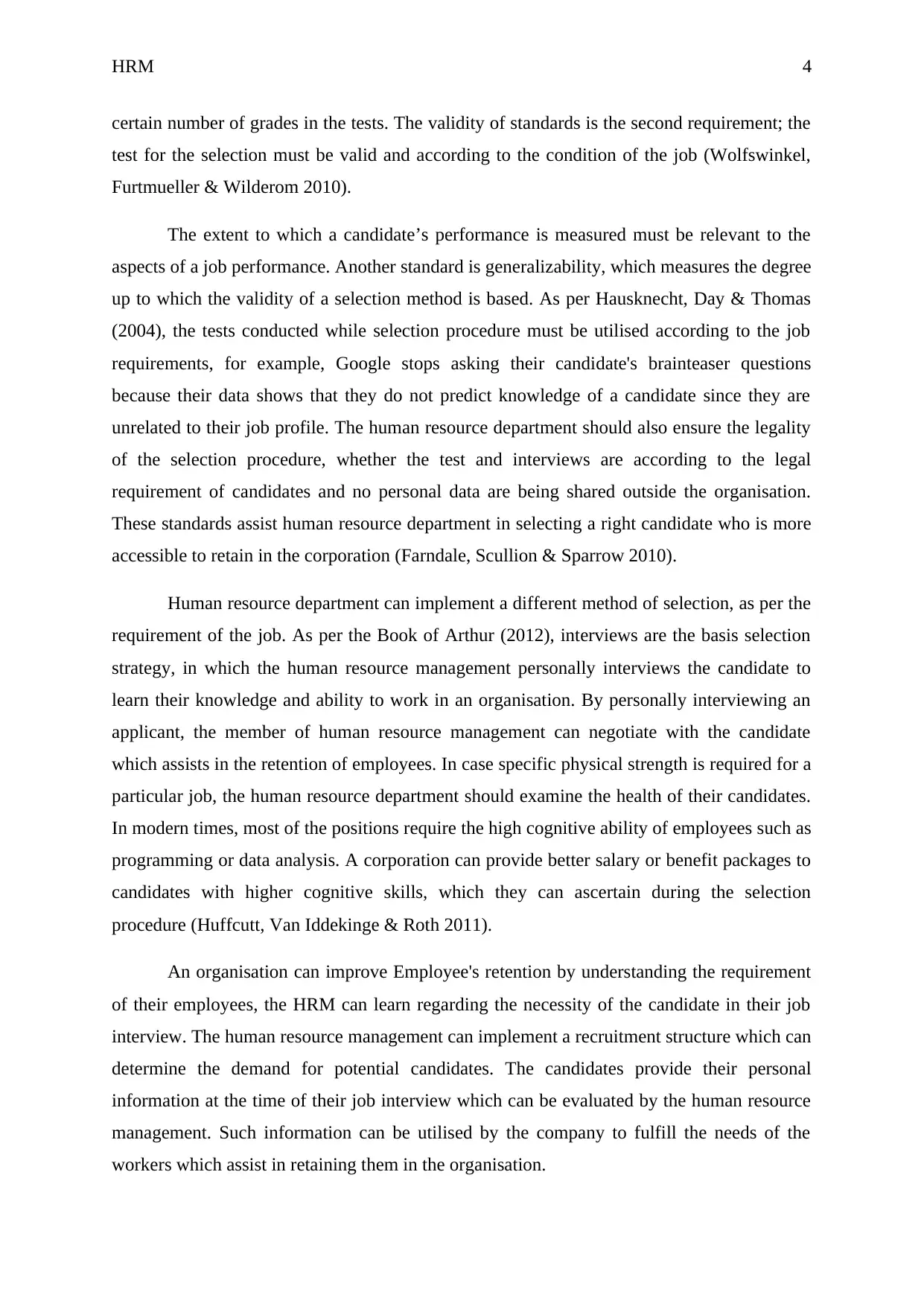
HRM 4
certain number of grades in the tests. The validity of standards is the second requirement; the
test for the selection must be valid and according to the condition of the job (Wolfswinkel,
Furtmueller & Wilderom 2010).
The extent to which a candidate’s performance is measured must be relevant to the
aspects of a job performance. Another standard is generalizability, which measures the degree
up to which the validity of a selection method is based. As per Hausknecht, Day & Thomas
(2004), the tests conducted while selection procedure must be utilised according to the job
requirements, for example, Google stops asking their candidate's brainteaser questions
because their data shows that they do not predict knowledge of a candidate since they are
unrelated to their job profile. The human resource department should also ensure the legality
of the selection procedure, whether the test and interviews are according to the legal
requirement of candidates and no personal data are being shared outside the organisation.
These standards assist human resource department in selecting a right candidate who is more
accessible to retain in the corporation (Farndale, Scullion & Sparrow 2010).
Human resource department can implement a different method of selection, as per the
requirement of the job. As per the Book of Arthur (2012), interviews are the basis selection
strategy, in which the human resource management personally interviews the candidate to
learn their knowledge and ability to work in an organisation. By personally interviewing an
applicant, the member of human resource management can negotiate with the candidate
which assists in the retention of employees. In case specific physical strength is required for a
particular job, the human resource department should examine the health of their candidates.
In modern times, most of the positions require the high cognitive ability of employees such as
programming or data analysis. A corporation can provide better salary or benefit packages to
candidates with higher cognitive skills, which they can ascertain during the selection
procedure (Huffcutt, Van Iddekinge & Roth 2011).
An organisation can improve Employee's retention by understanding the requirement
of their employees, the HRM can learn regarding the necessity of the candidate in their job
interview. The human resource management can implement a recruitment structure which can
determine the demand for potential candidates. The candidates provide their personal
information at the time of their job interview which can be evaluated by the human resource
management. Such information can be utilised by the company to fulfill the needs of the
workers which assist in retaining them in the organisation.
certain number of grades in the tests. The validity of standards is the second requirement; the
test for the selection must be valid and according to the condition of the job (Wolfswinkel,
Furtmueller & Wilderom 2010).
The extent to which a candidate’s performance is measured must be relevant to the
aspects of a job performance. Another standard is generalizability, which measures the degree
up to which the validity of a selection method is based. As per Hausknecht, Day & Thomas
(2004), the tests conducted while selection procedure must be utilised according to the job
requirements, for example, Google stops asking their candidate's brainteaser questions
because their data shows that they do not predict knowledge of a candidate since they are
unrelated to their job profile. The human resource department should also ensure the legality
of the selection procedure, whether the test and interviews are according to the legal
requirement of candidates and no personal data are being shared outside the organisation.
These standards assist human resource department in selecting a right candidate who is more
accessible to retain in the corporation (Farndale, Scullion & Sparrow 2010).
Human resource department can implement a different method of selection, as per the
requirement of the job. As per the Book of Arthur (2012), interviews are the basis selection
strategy, in which the human resource management personally interviews the candidate to
learn their knowledge and ability to work in an organisation. By personally interviewing an
applicant, the member of human resource management can negotiate with the candidate
which assists in the retention of employees. In case specific physical strength is required for a
particular job, the human resource department should examine the health of their candidates.
In modern times, most of the positions require the high cognitive ability of employees such as
programming or data analysis. A corporation can provide better salary or benefit packages to
candidates with higher cognitive skills, which they can ascertain during the selection
procedure (Huffcutt, Van Iddekinge & Roth 2011).
An organisation can improve Employee's retention by understanding the requirement
of their employees, the HRM can learn regarding the necessity of the candidate in their job
interview. The human resource management can implement a recruitment structure which can
determine the demand for potential candidates. The candidates provide their personal
information at the time of their job interview which can be evaluated by the human resource
management. Such information can be utilised by the company to fulfill the needs of the
workers which assist in retaining them in the organisation.
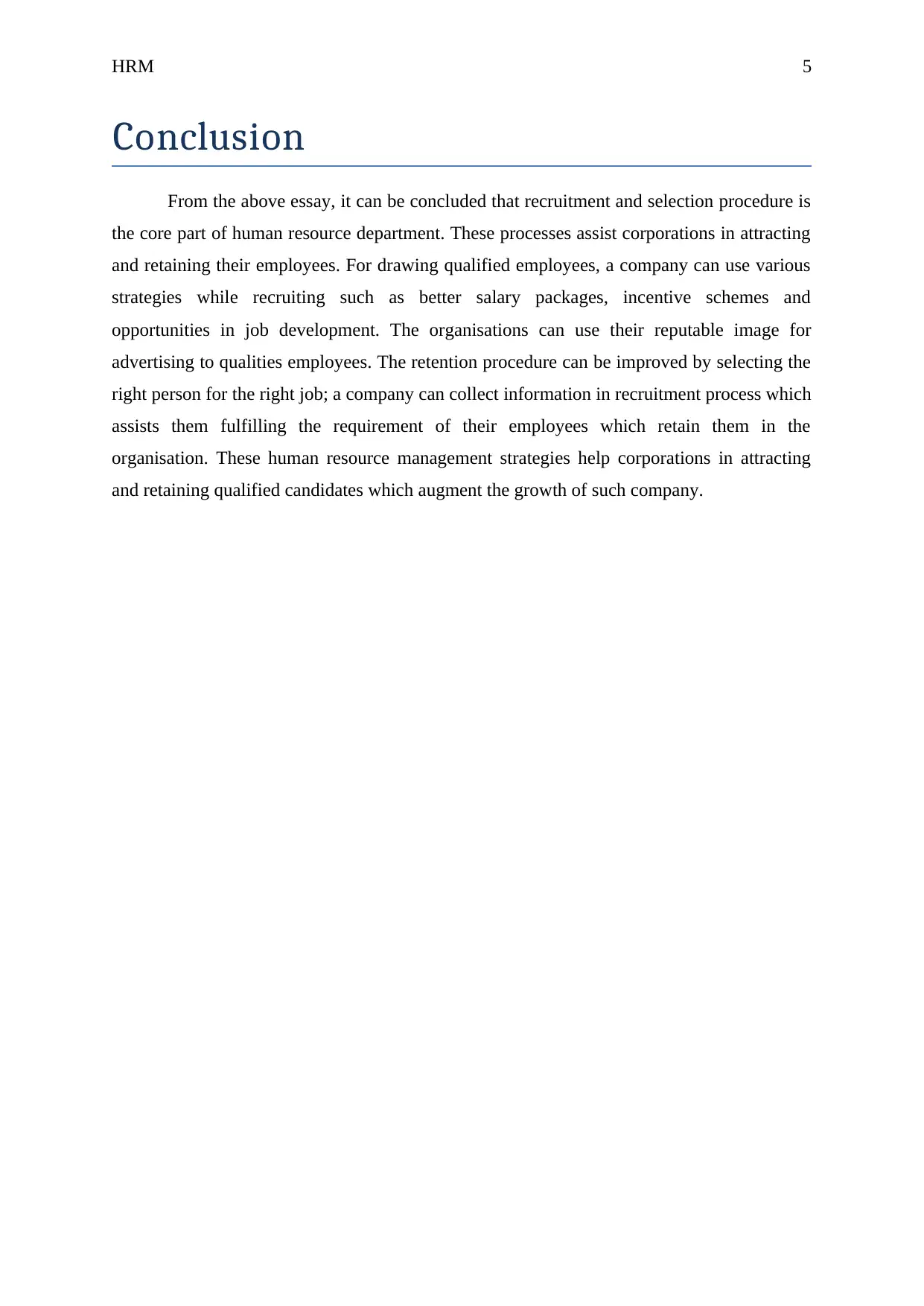
HRM 5
Conclusion
From the above essay, it can be concluded that recruitment and selection procedure is
the core part of human resource department. These processes assist corporations in attracting
and retaining their employees. For drawing qualified employees, a company can use various
strategies while recruiting such as better salary packages, incentive schemes and
opportunities in job development. The organisations can use their reputable image for
advertising to qualities employees. The retention procedure can be improved by selecting the
right person for the right job; a company can collect information in recruitment process which
assists them fulfilling the requirement of their employees which retain them in the
organisation. These human resource management strategies help corporations in attracting
and retaining qualified candidates which augment the growth of such company.
Conclusion
From the above essay, it can be concluded that recruitment and selection procedure is
the core part of human resource department. These processes assist corporations in attracting
and retaining their employees. For drawing qualified employees, a company can use various
strategies while recruiting such as better salary packages, incentive schemes and
opportunities in job development. The organisations can use their reputable image for
advertising to qualities employees. The retention procedure can be improved by selecting the
right person for the right job; a company can collect information in recruitment process which
assists them fulfilling the requirement of their employees which retain them in the
organisation. These human resource management strategies help corporations in attracting
and retaining qualified candidates which augment the growth of such company.
⊘ This is a preview!⊘
Do you want full access?
Subscribe today to unlock all pages.

Trusted by 1+ million students worldwide
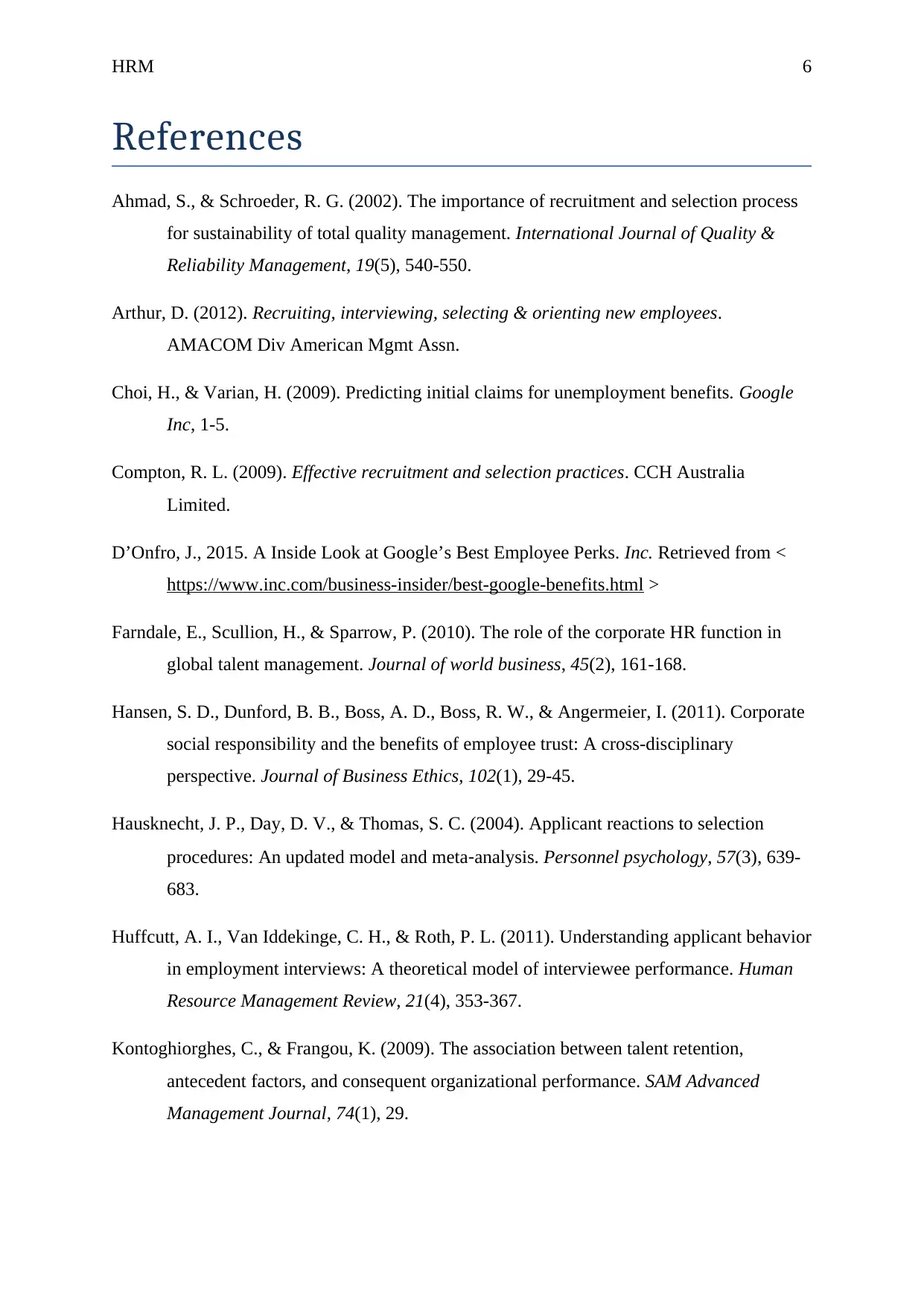
HRM 6
References
Ahmad, S., & Schroeder, R. G. (2002). The importance of recruitment and selection process
for sustainability of total quality management. International Journal of Quality &
Reliability Management, 19(5), 540-550.
Arthur, D. (2012). Recruiting, interviewing, selecting & orienting new employees.
AMACOM Div American Mgmt Assn.
Choi, H., & Varian, H. (2009). Predicting initial claims for unemployment benefits. Google
Inc, 1-5.
Compton, R. L. (2009). Effective recruitment and selection practices. CCH Australia
Limited.
D’Onfro, J., 2015. A Inside Look at Google’s Best Employee Perks. Inc. Retrieved from <
https://www.inc.com/business-insider/best-google-benefits.html >
Farndale, E., Scullion, H., & Sparrow, P. (2010). The role of the corporate HR function in
global talent management. Journal of world business, 45(2), 161-168.
Hansen, S. D., Dunford, B. B., Boss, A. D., Boss, R. W., & Angermeier, I. (2011). Corporate
social responsibility and the benefits of employee trust: A cross-disciplinary
perspective. Journal of Business Ethics, 102(1), 29-45.
Hausknecht, J. P., Day, D. V., & Thomas, S. C. (2004). Applicant reactions to selection
procedures: An updated model and meta‐analysis. Personnel psychology, 57(3), 639-
683.
Huffcutt, A. I., Van Iddekinge, C. H., & Roth, P. L. (2011). Understanding applicant behavior
in employment interviews: A theoretical model of interviewee performance. Human
Resource Management Review, 21(4), 353-367.
Kontoghiorghes, C., & Frangou, K. (2009). The association between talent retention,
antecedent factors, and consequent organizational performance. SAM Advanced
Management Journal, 74(1), 29.
References
Ahmad, S., & Schroeder, R. G. (2002). The importance of recruitment and selection process
for sustainability of total quality management. International Journal of Quality &
Reliability Management, 19(5), 540-550.
Arthur, D. (2012). Recruiting, interviewing, selecting & orienting new employees.
AMACOM Div American Mgmt Assn.
Choi, H., & Varian, H. (2009). Predicting initial claims for unemployment benefits. Google
Inc, 1-5.
Compton, R. L. (2009). Effective recruitment and selection practices. CCH Australia
Limited.
D’Onfro, J., 2015. A Inside Look at Google’s Best Employee Perks. Inc. Retrieved from <
https://www.inc.com/business-insider/best-google-benefits.html >
Farndale, E., Scullion, H., & Sparrow, P. (2010). The role of the corporate HR function in
global talent management. Journal of world business, 45(2), 161-168.
Hansen, S. D., Dunford, B. B., Boss, A. D., Boss, R. W., & Angermeier, I. (2011). Corporate
social responsibility and the benefits of employee trust: A cross-disciplinary
perspective. Journal of Business Ethics, 102(1), 29-45.
Hausknecht, J. P., Day, D. V., & Thomas, S. C. (2004). Applicant reactions to selection
procedures: An updated model and meta‐analysis. Personnel psychology, 57(3), 639-
683.
Huffcutt, A. I., Van Iddekinge, C. H., & Roth, P. L. (2011). Understanding applicant behavior
in employment interviews: A theoretical model of interviewee performance. Human
Resource Management Review, 21(4), 353-367.
Kontoghiorghes, C., & Frangou, K. (2009). The association between talent retention,
antecedent factors, and consequent organizational performance. SAM Advanced
Management Journal, 74(1), 29.
Paraphrase This Document
Need a fresh take? Get an instant paraphrase of this document with our AI Paraphraser
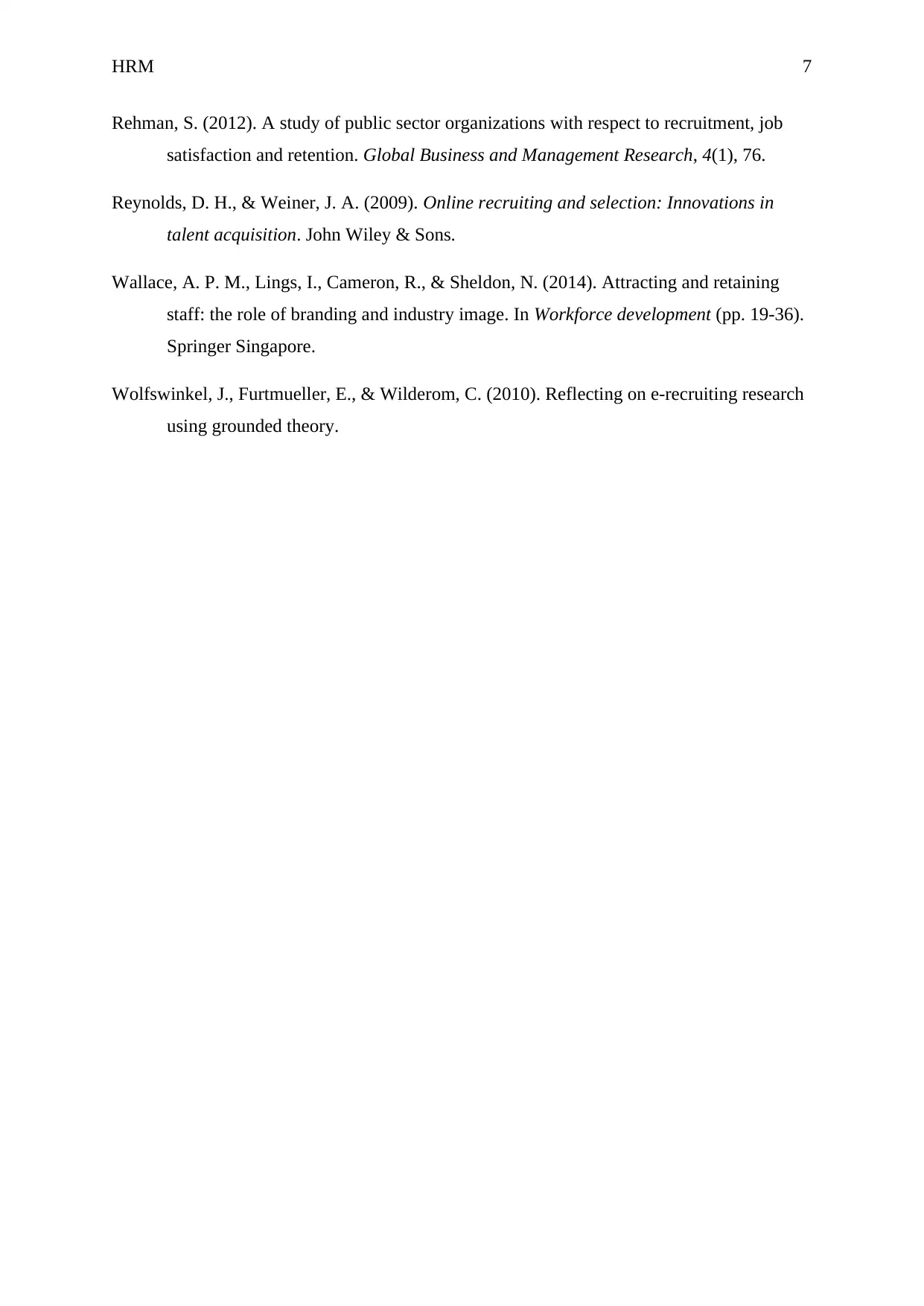
HRM 7
Rehman, S. (2012). A study of public sector organizations with respect to recruitment, job
satisfaction and retention. Global Business and Management Research, 4(1), 76.
Reynolds, D. H., & Weiner, J. A. (2009). Online recruiting and selection: Innovations in
talent acquisition. John Wiley & Sons.
Wallace, A. P. M., Lings, I., Cameron, R., & Sheldon, N. (2014). Attracting and retaining
staff: the role of branding and industry image. In Workforce development (pp. 19-36).
Springer Singapore.
Wolfswinkel, J., Furtmueller, E., & Wilderom, C. (2010). Reflecting on e-recruiting research
using grounded theory.
Rehman, S. (2012). A study of public sector organizations with respect to recruitment, job
satisfaction and retention. Global Business and Management Research, 4(1), 76.
Reynolds, D. H., & Weiner, J. A. (2009). Online recruiting and selection: Innovations in
talent acquisition. John Wiley & Sons.
Wallace, A. P. M., Lings, I., Cameron, R., & Sheldon, N. (2014). Attracting and retaining
staff: the role of branding and industry image. In Workforce development (pp. 19-36).
Springer Singapore.
Wolfswinkel, J., Furtmueller, E., & Wilderom, C. (2010). Reflecting on e-recruiting research
using grounded theory.
1 out of 8
Related Documents
Your All-in-One AI-Powered Toolkit for Academic Success.
+13062052269
info@desklib.com
Available 24*7 on WhatsApp / Email
![[object Object]](/_next/static/media/star-bottom.7253800d.svg)
Unlock your academic potential
Copyright © 2020–2025 A2Z Services. All Rights Reserved. Developed and managed by ZUCOL.





